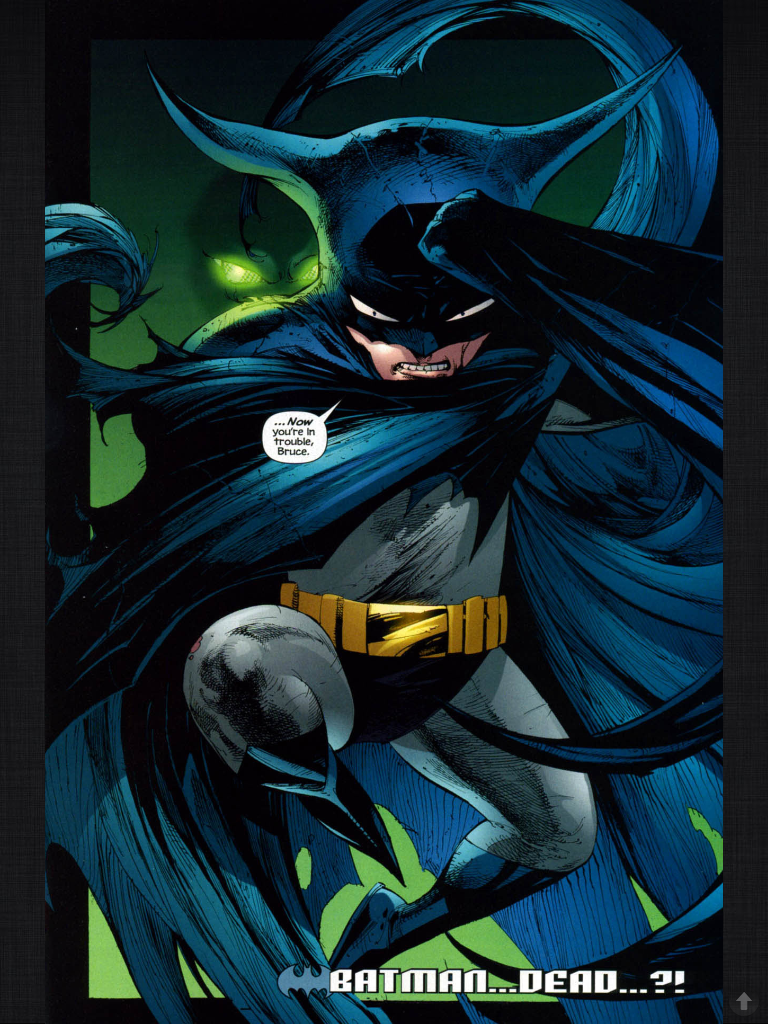Note: I am reprinting, without change, a series on Grant Morrison’s Batman work originally printed in 2013 on my old site.

Continuing an examination of the greatest comic book epic ever told, this time with Batman #672-674, which are all reprinted in The Black Glove trade paperback. This is where it gets deep. Or deeper, I should say.
These three issues take us way, way, waaaaaay down the rabbit hole.

The first of the three issues begins with one of the ghosts—“The Third Man,” a.k.a. “Bat-Devil” (from the future storyline starring Damian), storming the GCPD headquarters looking for Commissioner Lane. Instead, he finds Gordon. “The sleeper awoke,” he says…Much as Batman’s own implanted triggers are being activated, slowly, gradually, by circumstances and by the frequent drugs he’s being exposed to. In the process, we learn that there are others on the police force who know about Bat-Devil.
The book ends with Batman having a heart attack, and as his heartbeat flatlines, we see the words “Zur En Arrrh” emblazoned in his consciousness and out pops…Bat Mite.
Issue #673 is my favorite Morrison/Batman story of all time. Most (or maybe all) of it takes place in Batman’s subconscious, occurring during a four-minute period when he was dead of a heart attack caused by The Third Man. The tale is called “Joe Chill in Hell,” and it’s really about Batman wrestling with the demons of his creation—and his creator (Joe Chill, the man who shot Thomas and Martha Wayne) wrestling with what he created. It’s a brilliant piece of literature, truly, multilayered and complex. It’s also full of exposition: It finally becomes clear that Dr. Hurt is a partner to the Black Glove, and that he worked for Gotham Police Dept. and created the three Batmen as part of an experiment. The same experiment that implanted suggestions into Batman’s own brain—Batman was a willing participant.

Batman’s willingness to subject himself to isolation and loneliness becomes an increasingly stronger theme in these issues, one that plays out fully in the next major arc: Batman R.I.P.
Batman views his time spent meditating in isolation after his parents died as a period that made him stronger. Most of us do, too. Chris Nolan portrayed it that way in Batman Begins as well. It’s an accepted premise not only in American/Western culture (where it is epitomized by John Wayne) but in Eastern spiritual tradition as well (where detachment through meditation is an aspirational goal). In “Joe Chill in Hell,” and the stories that follow, Grant Morrison seems to be saying that this is a false belief.
Remember earlier, in the Resurrection of R’as a Ghul, where the story closed with a family together? Well, that final frame stood out—it was jarring—because it was so “unBatmanlike.” This is his struggle. Grant Morrison’s Batman can be characterized as a solitary, dark character—the way that he is traditionally portrayed. (Frank Miller is credited with turning Batman into a “mature” character, and all of Miller’s protagonists are lone wolves. He’s never written a team book.) But Morrison’s Batman can also been seen as a man who limits himself through isolation—even though he doesn’t realize it.
The irony of “Joe Chill in Hell” is that, in hell, Chill (the killer of Thomas and Martha Wayne) is plagued by Batman. It’s like a Greek myth, in which the same story plays out over and over for Joe Chill, and he’s always foiled by Batman, and always coming back to regretting his decision not to kill young Bruce when he had the chance. But in truth, it is Batman who is haunted by Chill. Batman may imagine that, through his work, he is redeeming the irredeemable moment of his parents’ murder and defeating the very crime that created him, but is that really the truth?
#674 concludes the Batman-is-held-captive arc, and much is revealed about the three ghosts and The Black Casebook. The ghosts were created by Commissioner Lane, during the period that Gordon was demoted to footpatrolman, and were trained to replace Batman, should he ever be killed. As part of their training, Dr. Simon Hurt managed to trick Batman into participating into an isolation experiment during which he dosed Batman with hallucinogens and let him fight the three ghosts. During the fight, Batman broke the hands of Ghost #1. “Bat-Bane,” a.k.a. Branca, was fed Hugo Strange’s monster serum and Bane’s venom serum. Branca then murdered his own family. And Simon Hurt, who dates back again to the Silver Age, is revealed to be a partner of The Black Glove. I summarize all this because it can be difficult to follow the plot at this point. Batman is becoming increasingly delusional, and Morrison brilliantly makes his own writing as difficult to penetrate as Bruce Wayne is finding his own existence.
Next: The death of Batman.

